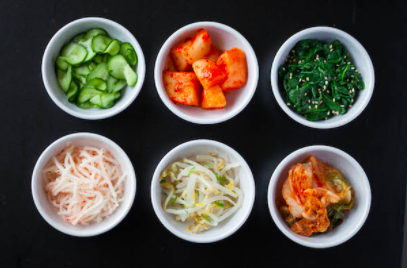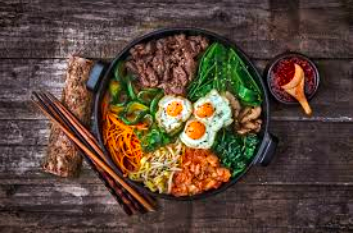What you need to know about Korean food
By Sam Bailey ‘23
Over the past five or so years, there has been has rather large resurgence of Korean/Korean fusion food, which have all risen in popularity. Why is this, and what makes this food so desirable?
First, we need a description of what these Korean restaurants have to offer. Traditionally in Korea, most foods are served in small portions at a consistent rate throughout the meal like small bowls of pickled vegetables and mushrooms and spicy fermented kimchi. Another very common meal is bibimbap, which is a dish usually served in a stone pot in which the rice remains cooking until browned and crispy. In the middle, there are steamed vegetables -- usually including spinach and pickled carrots with mushrooms -- and finished with steaming salty beef with the iconic fried egg on top.
Other well-known Korean dishes include seafood like spoon worm, live octopus, silkworm larvae, and an assortment of wild mushrooms.
There are several reasons why Korean food may be gaining in popularity. One, this style of eating includes a healthy balance of vegetables and lean meat with protein and egg, and with everything in small portions, it's much harder to overeat which is a common problem in the U.S. This is called banchan (반찬) and is the common form of dining found in Korea and many restaurants in the U.S. and even at Korean restaurants in Portland. The takeover of sushi and dim sum are a similar situation where a new Asian-style cuisine comes into the Western culture and is immediately welcomed with an abundance of enthusiasm.
Something else interesting to consider is the stigma against these strange foreign exotic foods in which we as sheltered Westerners don’t know much about. A lot of people in Portland are very excited about new types of food that they can explore, and Korean food just so happens to fall into that category. Especially with the rise of normalizing insects as being a reliable and more sustainable food source, some Korean food uses similar ingredients.
I recently ate several dishes from the restaurant Toki out on SW 12th and who happen to be the same people who started the restaurant Han Oak on NE 24th. We ordered Korean fried chicken, pork mandu, charbroiled mackerel, and vegetable dumplings. I can say with confidence that this was some of the best take-out food I have had all pandemic. The chicken was crispy with rice flour and a hot spice added a lot to the flavor. The dumplings were wonderfully warm and not at all dry as one might expect from take-out, and the mackerel had sides of rice and vegetables. All together, these foods made for an awesome dinner.
Here are some other recommendations I would make for Korean food:
FOMO Chicken (Link here)
Kim Jong Smokehouse (Link here)
The Bulgogi + Du Kuh Bee Noodle (Link here)
Kkoki Korean BBQ (Link here)
Essentials
These are the must haves, and the deciding factors to determining the quality of great Korean food.
Kimchi
Kimchi is the classic dish served alongside most any other plate one gets in any Korean restaurant. It comes in several different forms such as the radish (kkakdugi), stuffed cucumber (oi sobagi) or the spring onion (pa kimchi). My personal favorite is the cabbage (baechu kimchi). To get the hot tangy flavor required of great kimchi, it is prepared by radish marinade, chili paste, and then fermentation. When looking for good kimchi, it's always going to be rather spicy so this might not be for you if your spice tolerance is not high. Slightly crunchy cabbage soaked red with chili and sugar after a two-week marinade is the perfect side dish for any occasion.
Seaweed and Cucumber salad
This relatively simple dish is not as commonly found in restaurants nowadays, but is a very common homemade dish which is often used alongside cold noodle dishes. This salad is served as another side for most meals with kimchi. This vinegar and umami flavor is a great snack and a good cure for a spicy mouth.
Spring Onion K pancake
Possibly the most delicious pancake that I have ever eaten is this Korean onion pancake which also happens to be such a simple recipe that anyone can make it. With several Chinese and Japanese variations, this is a very common snack for people who are looking for a crunchy and oily pancake dipped in gochujang sauce. I could not recommend it any higher.


